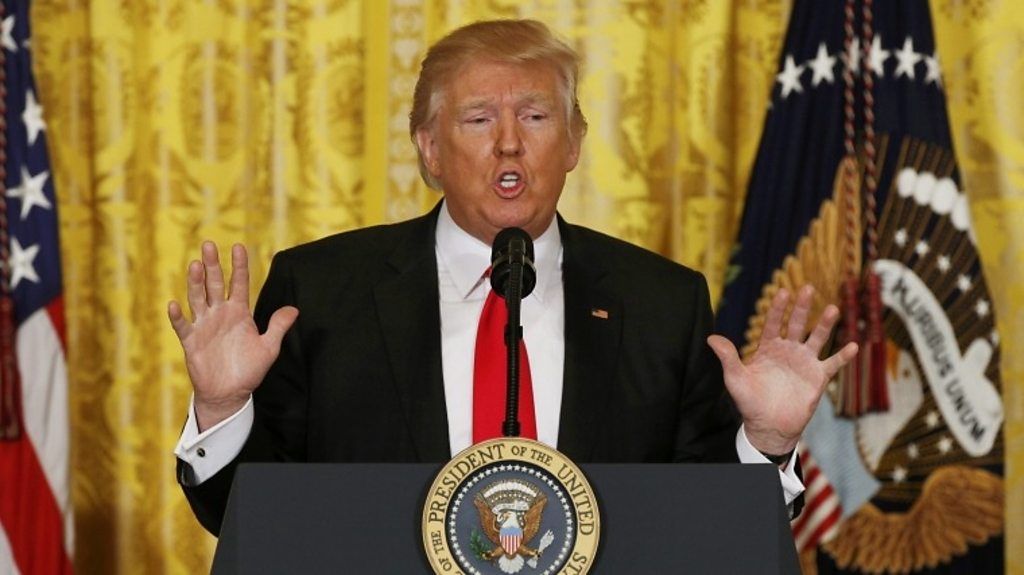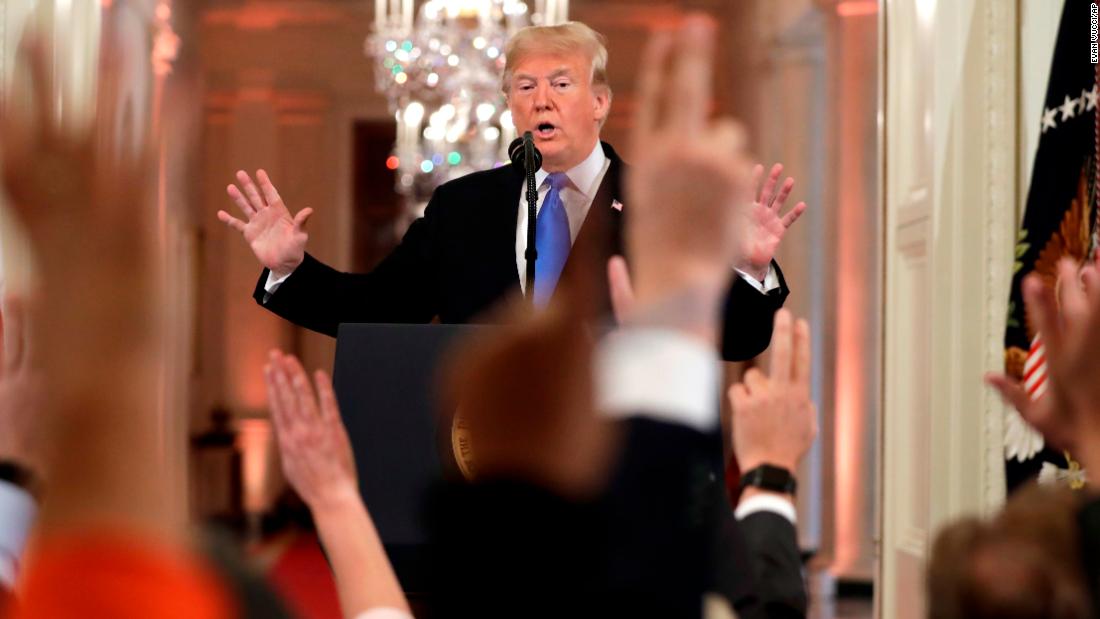Trump’s Press Conference Style

Donald Trump’s press conferences were a defining characteristic of his presidency, often generating significant media attention and public debate. His unique approach to communication, marked by a distinct tone, language, and interactions with the press, set him apart from his predecessors.
Trump’s Communication Style, Trump press conference
Trump’s press conferences were characterized by a highly confrontational and often combative style. He frequently used inflammatory language, personal attacks, and unsubstantiated claims, aiming to control the narrative and dictate the terms of engagement. His tone was often aggressive and dismissive, particularly when facing critical questioning. He frequently interrupted reporters, challenged their questions, and accused them of bias or dishonesty. This approach created a highly charged atmosphere, often leading to heated exchanges and confrontations.
Effectiveness of Trump’s Communication Style
Trump’s communication style was undeniably effective in reaching his base. His blunt and direct approach resonated with his supporters, who often appreciated his willingness to challenge conventional norms and speak his mind. His use of social media further amplified his message, allowing him to bypass traditional media outlets and connect directly with his audience. However, his approach was equally polarizing, alienating many who found his rhetoric offensive and divisive.
Comparison with Previous Presidents
Compared to his predecessors, Trump’s press conferences were marked by a significantly more adversarial tone and a greater emphasis on personal attacks. While previous presidents often engaged in heated exchanges with the press, they generally maintained a more respectful and professional demeanor. Trump’s approach, however, often crossed the line into personal insults and accusations, blurring the lines between political discourse and personal attacks.
Impact on Public Opinion
Trump’s press conferences had a significant impact on public opinion, both positively and negatively. His supporters often found his bluntness and willingness to challenge the status quo refreshing, while his detractors found his rhetoric divisive and harmful. His confrontational style further polarized public opinion, deepening existing divisions and creating a climate of hostility and distrust.
Key Themes and Messages

Donald Trump’s press conferences were characterized by a distinct set of themes and messages that evolved over time and were closely intertwined with his political agenda. These conferences served as a platform for him to directly engage with the public, bypassing traditional media outlets and shaping the narrative surrounding his administration.
Themes and Messages
Trump’s press conferences were often marked by a focus on specific themes and messages, which shifted and evolved throughout his presidency. Here are some of the most prominent:
- “America First”: This theme was central to Trump’s political ideology, emphasizing nationalistic policies and prioritizing American interests over international cooperation. He frequently highlighted the economic benefits of his policies for American workers and businesses, often contrasting them with the perceived disadvantages of globalization and trade deals.
- “Fake News”: Trump frequently attacked the media, labeling critical coverage as “fake news” and accusing journalists of bias and dishonesty. This strategy aimed to undermine public trust in traditional media outlets and promote his own narrative.
- “Winning”: Trump often framed his policies and actions as victories, emphasizing his ability to achieve success for the American people. He frequently boasted about his accomplishments, emphasizing his strength and decisiveness.
- “The Swamp”: Trump frequently used this term to refer to the political establishment in Washington, D.C., which he portrayed as corrupt and ineffective. He presented himself as an outsider fighting against this entrenched system, appealing to voters who felt disillusioned with traditional politics.
- “Law and Order”: Trump emphasized the importance of law and order, particularly in response to protests and unrest. He often framed these issues as threats to public safety and national security, justifying his use of force and his tough stance on crime.
- “The Deep State”: Trump frequently alleged the existence of a “deep state” within the government, a clandestine group of bureaucrats working to undermine his presidency. This theme was often used to explain setbacks or criticism he faced, further fueling his narrative of being an outsider battling against a powerful and secretive force.
Evolution of Themes
Trump’s themes and messages evolved over time, often reflecting the political climate and his own evolving priorities. For example, his focus on “fake news” intensified during periods of intense media scrutiny, while his emphasis on “law and order” became more pronounced in the wake of protests and unrest.
Relationship to Political Agenda
The themes and messages Trump conveyed in his press conferences were closely intertwined with his political agenda. His emphasis on “America First” fueled his policies on trade, immigration, and foreign affairs. His attacks on “fake news” were often aimed at discrediting media coverage that was critical of his administration. His focus on “winning” was a key component of his campaign strategy, emphasizing his success in achieving his goals. His attacks on “the swamp” and “the deep state” helped him to maintain a sense of outsider status and to rally his base of supporters.
Communication Strategies
Trump employed a number of strategies to communicate his messages effectively. He frequently used repetition, emphasizing key themes and messages multiple times in his speeches and interviews. He also relied on personal anecdotes and emotional appeals to connect with his audience. He often employed hyperbole and exaggeration to make his points, and he frequently attacked his opponents and critics.
Impact on Media Coverage and Public Discourse: Trump Press Conference

Trump’s press conferences had a profound impact on media coverage of his presidency and significantly shaped public discourse surrounding his policies. These events became focal points for news outlets, influencing how his administration was perceived and understood by the public.
Influence on Media Coverage
Trump’s press conferences were often characterized by their length, their contentious nature, and the president’s tendency to make controversial statements. This created a media environment where coverage was heavily focused on these events, with news outlets devoting significant resources to reporting on them. This, in turn, led to a situation where the public’s understanding of Trump’s presidency was often shaped by these events.
Role in Shaping Public Discourse
Trump’s press conferences played a key role in shaping public discourse surrounding his policies. The events provided a platform for the president to directly communicate his views and policies to the public, bypassing traditional media filters. This direct communication often led to heated debates and discussions, both in the media and among the public.
Impact on the Relationship Between the Press and the Presidency
Trump’s press conferences often featured confrontational exchanges between the president and reporters, leading to a strained relationship between the press and the presidency. Trump frequently criticized the media, labeling them “fake news” and accusing them of bias. This rhetoric contributed to a climate of distrust and hostility between the president and the press, making it more difficult for journalists to hold the administration accountable.
Shaping Narratives and Influencing Public Opinion
Trump’s press conferences were often used to shape narratives and influence public opinion. He would frequently use these events to promote his agenda, attack his opponents, and deflect criticism. By controlling the flow of information and presenting his own version of events, Trump was able to influence how his presidency was perceived by the public. For example, Trump often used press conferences to attack his political opponents, accusing them of corruption or incompetence. He also used these events to promote his policies, such as his tax cuts or his border wall, often framing them as solutions to pressing problems.
Trump press conferences were known for their unpredictable nature, often veering into territory that surprised even seasoned journalists. To understand the context of these events, it’s crucial to look back at the trump news conference today and analyze the themes and rhetoric that emerged.
These events, while controversial, provided a unique window into the political landscape of the time, showcasing both the strengths and weaknesses of the Trump administration.
Trump press conferences have become a regular feature of American politics, often filled with dramatic pronouncements and heated exchanges. Today’s press conference, trump press conference today , promises to be no different, as the former president continues to make headlines with his controversial statements and actions.